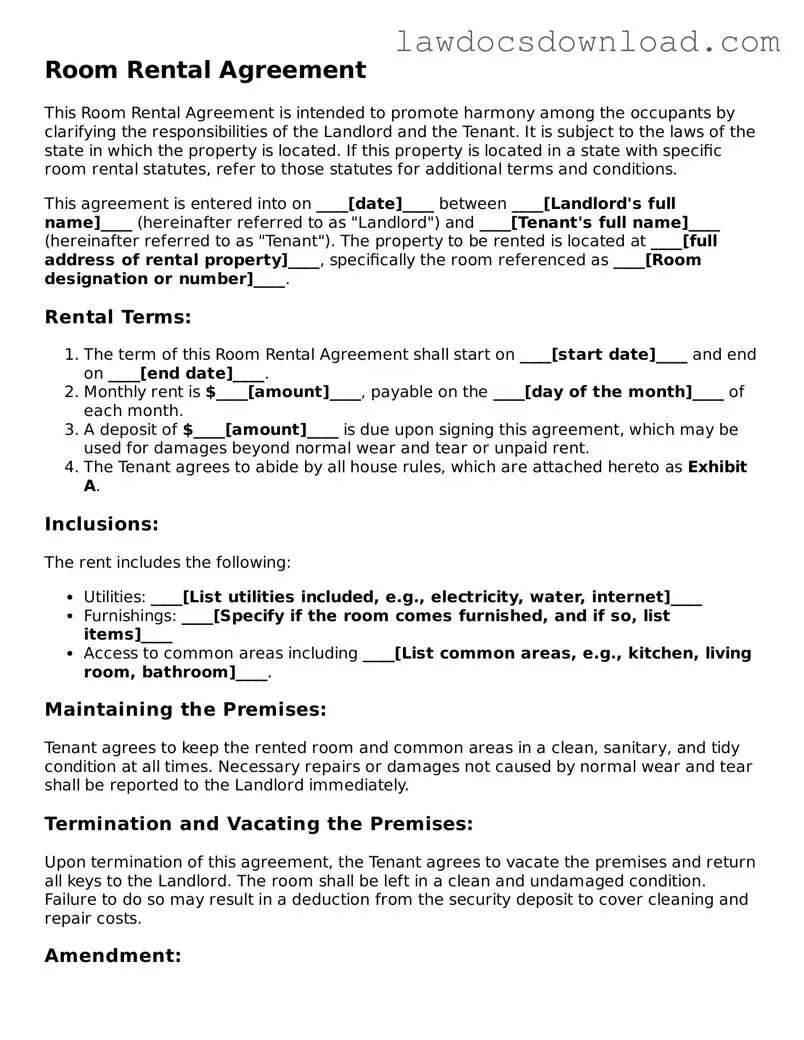A Lease Agreement, often drafted for longer terms, shares similarities with a Room Rental Agreement in that both establish the rights and responsibilities of the landlord and the tenant. While a Room Rental Agreement typically focuses on one room within a property, a Lease Agreement generally encompasses the rental of an entire property. Both documents outline payment schedules, security deposit details, and the conditions under which a lease can be terminated.
Like Sublease Agreements, Room Rental Agreements allow a tenant (sub-lessor) to rent out a portion of their leased space to another tenant (sub-lessee). Sublease Agreements, however, usually pertain to the rental of an entire property or apartment, as opposed to a single room, yet both types of agreements define terms about rent, utility payments, and the duration of the sublease.
A Tenancy At Will Agreement, similar to a Room Rental Agreement, is characterized by the flexibility it offers both parties, allowing the landlord or tenant to terminate the agreement at any time with proper notice. Unlike the fixed term of a Room Rental Agreement, a Tenancy At Will does not stipulate a specific end date, reflecting its more temporary and flexible nature.
Lodger Agreements, commonly used when renting a room in a landlord’s home, closely resemble Room Rental Agreements by detailing the rights and obligations of someone renting a room (the lodger) and the property owner. Both agreements typically include terms on rent, house rules, and shared facility use but are specific to situations where the landlord resides in the property.
Property Management Agreements are designed for scenarios where property owners hire managers to oversee their rental properties, and share some overlap with Room Rental Agreements where operational aspects of the rental arrangement are concerned. These agreements outline the manager’s responsibilities, from collecting rent to handling maintenance issues, similar to the way a Room Rental Agreement might between a landlord and tenant.
A Vacation Rental Agreement is applied to short-term rentals, much like Room Rental Agreements can be, but focuses on temporary accommodation, often for vacation purposes. Both agreements specify the length of stay, payment details, and house rules, though Vacation Rental Agreements usually include more specifics on check-in/check-out times and housekeeping arrangements.
Co-Tenancy Agreements are made between roommates who share a rental property, defining how rent, utility costs, and other responsibilities are divided among them. Though a Room Rental Agreement might only involve the property owner and one tenant, the essence of sharing responsibilities and defining usage rights is a common thread in Co-Tenancy Agreements when multiple tenants are involved.
An Equipment Rental Agreement, while focused on the leasing of equipment rather than real estate, shares the principle of outlining the terms and conditions under which one party agrees to rent equipment from another. Both this agreement and a Room Rental Agreement detail the duration of the rental period, payment terms, and liability in case of damage or loss.
Lastly, Pet Addendums to leases or rental agreements, which specify the conditions under which a pet may reside in the rental property, have an indirect similarity to Room Rental Agreements. Although focusing specifically on pets, these addendums, like Room Rental Agreements, modify the original rental agreement to accommodate an additional term, ensuring both parties are clear on the rules and responsibilities concerning pets.
